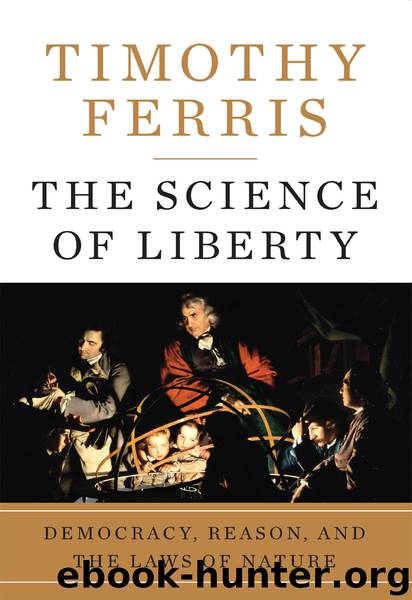The Science of Liberty by Timothy Ferris

Author:Timothy Ferris
Language: eng
Format: epub
Publisher: HarperCollins
Published: 2010-06-06T16:00:00+00:00
a war of masses of men hurling masses of shells at each other. It is by devising new weapons, and above all by scientific leadership, that we shall best cope with the enemy’s superior strength…. The multiplication of the high-class scientific personnel, as well as the training of those who will handle the new weapons and research work connected with them, should be the very spear-point of our thought and effort.
“Unless British science had proved superior to German,” Churchill later wrote, “we might well have been defeated, and, being defeated, destroyed.”
His seriousness on this point was evident to the young physicist Reginald Victor Jones, who had been researching the infrared spectrum of the sun when the war intervened. Appointed Britain’s first scientific intelligence officer at age twenty-eight, Jones investigated the possibility that the Germans were using intersecting radio beams to signal their pilots where to release their bombs. Summoned to a meeting at Ten Downing Street in June 1940, the young Jones suspected a practical joke, but instead found himself seated at a table where Britain’s top air force officers, with Churchill presiding, were discussing the German radio-beam puzzle. After listening for a while to their groping conversation, which to Jones “suggested that they had not fully grasped the situation,” he was asked by Churchill to clear up a technical point. Instead he said, “Would it help, sir, if I told you the story right from the start?” Churchill was startled but replied, after a moment of hesitation, “Well, yes it would!” Jones spoke for twenty minutes, explaining his research and urging that British pilots fly along the German beams for themselves to learn how they worked. Such flights began the following day. British engineers were soon jamming the Germans’ signals, a key step in ending the night-bombing raids and ultimately the Blitz—which had destroyed over a million homes, more than were consumed in the Great Fire of London in 1666. Jones recalled of Churchill that “he valued science and technology at something approaching their true worth.”
This is not to say that the Allies were immune to the difficulties posed by bureaucratic opacity and conservatism—indeed British and American scientists often complained of just that—or that German scientists were never able to cut through red tape and get anything done. But on the whole, wartime scientific and technological development fared far better in the liberal democracies.
The failure of the Germans to develop nuclear weapons—a failure that surprised the Allies, who had invested in the Manhattan Project out of the quite sensible fear that the Nazis would otherwise get there first—also reflected the hobbled state of communications among the scientists and engineers involved. Historians differ sharply over whether Heisenberg, whom Hitler appointed to head up the German A-bomb project, deliberately let the project languish, but whatever his motives, his approach was a far cry from the egalitarian ethos of the Manhattan Project. Disinclined toward laboratory work, Heisenberg played Bach fugues on the chapel organ at Hechingen while his subordinates there conducted nuclear experiments with uranium, graphite, and heavy water.
Download
This site does not store any files on its server. We only index and link to content provided by other sites. Please contact the content providers to delete copyright contents if any and email us, we'll remove relevant links or contents immediately.
Enlightenment Now: The Case for Reason, Science, Humanism, and Progress by Steven Pinker(7272)
A Journey Through Charms and Defence Against the Dark Arts (Harry Potter: A Journey Through…) by Pottermore Publishing(4789)
The Immortal Life of Henrietta Lacks by Rebecca Skloot(4548)
A Journey Through Divination and Astronomy by Publishing Pottermore(4363)
Elon Musk by Ashlee Vance(4082)
Origin Story: A Big History of Everything by David Christian(3665)
COSMOS by Carl Sagan(3586)
Alchemy and Alchemists by C. J. S. Thompson(3480)
Bad Pharma by Ben Goldacre(3396)
Enlightenment Now by Steven Pinker(3349)
Shadow of Night by Deborah Harkness(3324)
Inferior by Angela Saini(3293)
A Mind For Numbers: How to Excel at Math and Science (Even If You Flunked Algebra) by Barbara Oakley(3256)
Origin Story by David Christian(3170)
The Code Book by Simon Singh(3131)
Signature in the Cell: DNA and the Evidence for Intelligent Design by Stephen C. Meyer(3098)
The Elements by Theodore Gray(3025)
A Brief History of Time by Stephen Hawking(2991)
A Journey Through Potions and Herbology (A Journey Through…) by Pottermore Publishing(2836)
